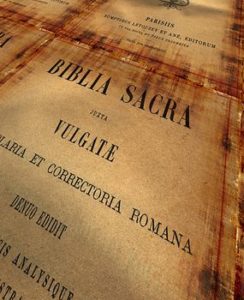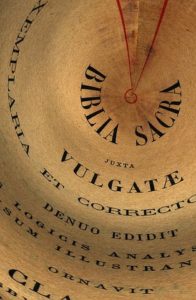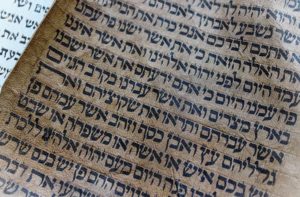Translations
“See to it that no one takes you captive through philosophy and empty deception, according to the tradition of men, according to the elementary principles of the world, rather than according to Christ.” –Colossians 2:8
Over the last two weeks we looked at the transmission of both the Old and New Testament, from the time of Moses through the fourth century AD/CE. Up to that point the original languages of Hebrew, Aramaic (a few parts of Daniel and Ezra), and Greek were the only ones available for reading the text of the Bible. For the first three centuries from the time of Jesus the Christian Church was at its purest form. They studied the Hebrew Scriptures (the Old Testament) and how it pointed to the person of Jesus, and the New Testament was in the form of letters and writings that were copied and passed from group to group as they were read out loud during worship gatherings. This early Church was often forced to meet in secret because of persecution from both the Jewish and Roman Authorities.
The Roman Emperor Constantine became a Christian in the fourth century. At this point persecution basically ended and Church and State became blended. For the next one thousand years the Church of Rome would rule religiously, and have major political influence worldwide.
The Latin Vulgate
- Latin replaced Greek as the universal language about the middle of the third century
- Jerome, an Italian Hebrew scholar, translated both the Old and New Testaments from the original languages into Latin
- The Latin Vulgate became so popular, and so identified with the Church of Rome, that it became blasphemous to have the Bible in any other language
From this point on history will show that the Christian Church failed when it did not equip everyday Christians with the truths of their faith and how to defend it. The common people at that time, being mostly illiterate, were not allowed to read the Bible, let alone own one. Over the next one thousand years the Church of Rome would only allow Scripture to be read from the Latin Vulgate by the leaders in the Church.
During this time leadership in the Church of Rome twisted many of the Biblical doctrines, adding rules and regulations that the people had to follow or suffer penalties. This continued until the time of the printing press when literacy rates increased and people like Martin Luther were able to get the Bible into the common person’s hands.
Critics of Christianity will cite this “thousand year dark period” as a time when wars and oppression started in the name of Christ (i.e. Crusades and Inquisitions). However, when the true teachings of Jesus were finally revealed to the common person it showed that Christianity never promoted such things. Critics are silenced when they realize that Biblical Christianity and the teachings of Jesus are in complete opposition, for example, to the teachings of Mohammad and the Quran that does promote violence and conquest.
Important Note: Over the centuries whenever there have been times of crisis whether it be wars, famine, or plagues, we find real Christians, followers of Jesus, running in to help those in need while everyone else is running out. This is what Christianity teaches at its core because that is what Jesus modeled.
In the fifteenth through sixteenth centuries AD/CE The Protestant reformation began.
It was during this period of time Martin Luther and others began to translate the Bible into common languages. With the advent of the Printing Press for the first time people could acquire and read the Bible for themselves. Some of the false teachings and interpretations by the Church of Rome were vividly exposed. Unfortunately Christian oppression happened again in places like England. The Pilgrims and others would leave in hopes of finding religious freedom in a new world, only to repeat the mistakes of the past.
Watch this short clip, produced by “Museum of the Bible,” to better explain what Martin Luther did:
Bible Warriors
The dark ages imposed by the Church of Rome had lead to Biblical illiteracy and a dependence on Church leaders to teach the people. However, the work of missionaries from Martin Luther on would bring a multitude of translations to the common person. This work continues today through Christian Churches worldwide. Missionaries are still risking their lives to get God’s Word to people around the world.
In many instances people gave their lives to translate the Bible for the common person apart from the Latin Vulgate. Here are just a few examples of men who helped increase Biblical literacy worldwide:
- John Wycliffe: 1384 (bones were ground to dust for making an English translation)
- Martin Luther: 1522 (excommunicated and went into hiding due to death threats)
- William Tyndale: 1530 (burned at the stake)
- John Knox and Miles Coverdale: 1560 (exiled – both worked on the Geneva Bible)
- King James: 1611 (commissioned some 54 translators – Version still used today)
Can we trust the translations we have today? YES!
The Bible can be studied today by almost anyone of any language. We don’t have to depend on others to tell us what the Word of God says we can read it for ourselves. Serious students of the Bible can consult the original languages for accurate meaning in their translation because the original languages are not lost languages!
Beware of groups that teach only one version is the correct one. Cults like Jehovah Witnesses and others have their own translations and will not allow for the original languages and early versions to be used to contradict their “Bible.” Many of these groups, like J.W.s, have their own translators and refuse to discuss the multitude of early manuscripts that dispute their single translation. Christianity, on the other hand, is more than willing to look at all of the versions for cross-referencing and study, along with the original languages. Most Christian study Bibles have footnotes of differences when applicable, and transparency is of utmost importance.
All of the major translations of the Bible today have come from the original Hebrew, Aramaic, and Greek—they are called Versions (they have not been copied from one language to another to another as skeptics might claim). The different versions are designed to help the reader understand what is being taught from the original language. The translations and versions can be categorized as seen in the chart:
| Translation type | Description | Common Versions |
| Word for Word | Literal, formal, or complete equivalence. Generally harder to read as it works closely as possible to the original languages.
Best type to use for study purposes. |
King James Version (KJV) and New King James Version (NKJV), New American Standard Version/Bible (NASB), English Standard Version (ESV), New Revised Standard Version (NRSV) |
| Thought for Thought | Dynamic equivalence. Much easier to read and understand. Focuses on the ideas or contemporary concepts while keeping the original meaning.
Can be used for study purposes. |
New International Version (NIV), New Living Translation (NLT), Contemporary English Version (CEV), Holman Christian Standard Bible (HCSB), Today’s English Version (TEV) |
| Paraphrases | Simplifies or expands the author’s word to make the Bible easier to understand. Often in story-like form. Not a translation in a literal sense.
Not recommended for study purposes. |
The Message Bible
The Living Bible Phillip’s Bible (Most children’s Bibles) |
All of the major versions can also be found in topical or study Bibles. Some are focused on particular groups or subjects. For example, there are student study Bibles, Bibles for men or women, and Bibles that have a specific focus like apologetics, archeology, culture, and life application.
Watch Josh McDowell’s presentation based on the book: “Evidence that Demands a Verdict, Life Changing Truth for a Skeptical World,” by Josh McDowell and Dr. Sean McDowell. This is their 2017 updated and expanded version of the classic.
Going Deeper:
Read the book: “The Bible in Translation, Ancient and English Versions,” by Bruce M. Metzger
Reflection Questions:
- What translation do you use for your Bible reading and study time? Identify its translation type.
- What are some things we can do to help fellow Christians go deeper in their studies of the Bible?
- Prayer focus: Ask God to show you your role in helping others (and yourself) go deeper in the study of the Bible.
Join us next week as we look at how the books of the Bible were chosen (canonization).
————————————————————————————————————————————————————
You will not find this material in the public school curriculum even though it is based on solid evidence and grounded in research. It is ironic that following the evidence to where it leads stops at the door of our public schools as they will not let a “Divine footprint” in! Join us as we examine evidence for Christianity and learn how to become a thoughtful defender and ambassador of your faith.
Click into the resource page of this website to view many of the top Christian thinkers and apologists along with some of their work; connecting to these types of resources is essential in your Christian growth.
Please let me know what you think: Give feedback, ask questions or send concerns in the comment section of the blog.
Teri Dugan
TeriDugan@truthfaithandreason.com
1 Peter 3:15





Sorry, comments are closed for this post.